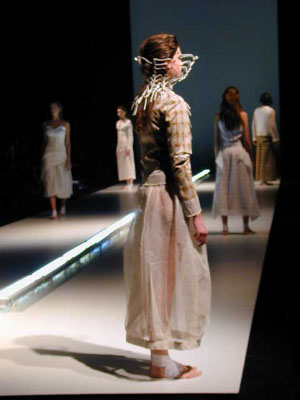THE 4TH BUENOS AIRES FASHION WEEK
Nadine Zlotogora is one of the most well known designers in the local scene. That is why her show was the last one at this Buenos Aires Fashion Week (BAF)’s edition. At the previous BAF, Nadine chose to locate the scene in an orphanage, so the models were the scared children who inhabited it. The stress and helplessness of their run moved everyone, even the ones who critique the theatrical exposure.
This time, models wore orthopaedic devices, and represent sick people about to recover. They stop by the sides of the runway looking at the public that debates itself between returning the fixed look or turning the other way searching for a more placid image. The metallic music that accompanies the walk completes the scene. It is a smart show, though uneasy to digest by those used to the glamour of volatile runways, waiting for a non-transcendent fashion event.

Nadine admits, stunned, that her presentations have always a theatrical effect, “a dramatization for my people.” Zlotogora goes back to her multicultural roots and profound traditions of each country to explain her designs and she reveals the feeling that moves her to make wearable everyday clothes with a romantic touch, closer to fantasy than reality. The audience that identifies with her style is varied, but the common denominator is sensibility and sense of perception.

Zlotogora made the spring-summer collection she presented in the latest Bafweek in only 15 days. But she knew. She held the fabrics between her hands and felt the textures and she knew. “I read my feeling, then found a setting, and after that I made the garments,” she says naturally. She also knew she wanted some reaction from the people when they heard the music. And people were ecstatic and vibrated with the music in a powerful way, letting themselves feel caught up by the pale runway figures.
People dressed in elastics, entwined wire, trellis and orthopaedic elements by which she symbolized the double process of pressure and oppression that signed her collection. The pressure that forces her to grow up and face the fear of jumping towards something that resembles a void. On the other side, there’s oppression of the order. “They tell you to run, but they keep you locked in,” says Nadine, who uses her rebelliousness to look for a way of moldering the oppression, so “people don’t end up getting hurt.” Oppression turns into a retainer through flexible structures that allow movement while growing up.
Nadine combines sentimental and analytical thinking, and assures “I think thoroughly about the collection before I have it made. I know exactly what I want it to be, before much is finished. You may not understand many things, but you perceive them.”
Even though many people say her style is unconventional and less likely to sell, Nadine assures “I don’t have the choice to look for more commercial stuff. It was born that way and it will remain like that.”
4th Buenos Aires Fashion Week
Date: September 3rd – 6th , 2002
Place: Buenos Aires, Argentina
info@bafweek.com
https://www.bafweek.com
Text: Gisella Lifchitz
Photos: Gisella Lifchitz




